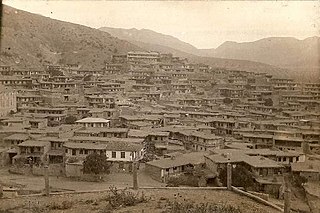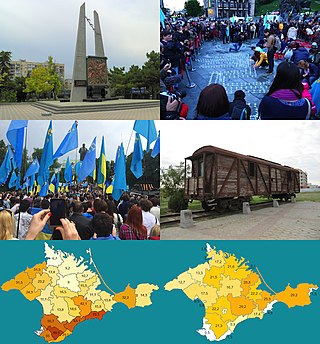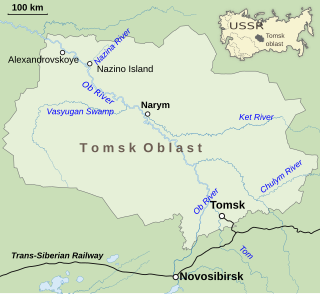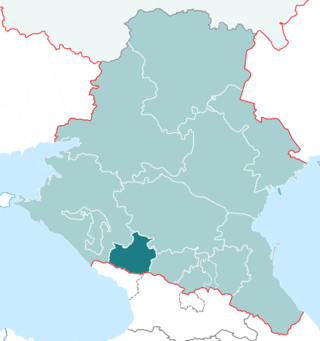
The Gulag was a system of forced labor camps in the Soviet Union. The word Gulag originally referred only to the division of the Soviet secret police that was in charge of running the forced labor camps from the 1930s to the early 1950s during Joseph Stalin's rule, but in English literature the term is popularly used for the system of forced labor throughout the Soviet era. The abbreviation GULAG (ГУЛАГ) stands for "Гла́вное Управле́ние исправи́тельно-трудовы́х ЛАГере́й", but the full official name of the agency changed several times.

The Great Purge, or the Great Terror, also known as the Year of '37 and the Yezhovshchina, was Soviet General Secretary Joseph Stalin's campaign to consolidate his power over the Communist Party of the Soviet Union and Soviet state. The purges also sought to remove the remaining influence of Leon Trotsky. The term great purge, an allusion to the French Revolution's Reign of Terror, was popularized by the historian Robert Conquest in his 1968 book The Great Terror.

The Volga Germans are ethnic Germans who settled and historically lived along the Volga River in the region of southeastern European Russia around Saratov and close to Ukraine nearer to the south.

From 1930 to 1952, the government of the Soviet Union, on the orders of Soviet leader Joseph Stalin under the direction of the NKVD official Lavrentiy Beria, forcibly transferred populations of various groups. These actions may be classified into the following broad categories: deportations of "anti-Soviet" categories of population, deportations of entire nationalities, labor force transfer, and organized migrations in opposite directions to fill ethnically cleansed territories. Dekulakization marked the first time that an entire class was deported, whereas the deportation of Soviet Koreans in 1937 marked the precedent of a specific ethnic deportation of an entire nationality.

The Kalmyk deportations of 1943, codename Operation Ulusy was the Soviet deportation of more than 93,000 people of Kalmyk nationality, and non-Kalmyk women with Kalmyk husbands, on 28–31 December 1943. Families and individuals were forcibly relocated in cattle wagons to special settlements for forced labor in Siberia. Kalmyk women married to non-Kalmyk men were exempted from the deportations. The government's official reason for the deportation was an accusation of Axis collaboration during World War II based on the approximately 5,000 Kalmyks who fought in the Nazi-affiliated Kalmykian Cavalry Corps. The government refused to acknowledge that more than 23,000 Kalmyks served in the Red Army and fought against Axis forces at the same time.
NKVD troika or Special troika, in Soviet history, were the People's Commissariat of Internal Affairs made up of three officials who issued sentences to people after simplified, speedy investigations and without a public trial. The three members were judge and jury, though they themselves did not carry out the sentences they dealt. These commissions were employed as instruments of extrajudicial punishment introduced to supplement the Soviet legal system with a means for quick and secret execution or imprisonment. It began as an institution of the Cheka, then later became prominent again in the NKVD, when it was used during the Great Purge to execute many hundreds of thousands of Soviet citizens. Defendants in the Troika's proceeding were typically not entitled to legal aid or the presumption of innocence. Convictions usually did not include information about the actual incriminating evidence and basically contained only information about indictment and sentencing. The outcome of such trials was often determined before it even began due to targeted numbers of citizens to be executed or imprisoned in Gulag prison camps.

The Soviet deportations from Bessarabia and Northern Bukovina took place between late 1940 and 1951 and were part of Joseph Stalin's policy of political repression of the potential opposition to the Soviet power. The deported were typically moved to so-called "special settlements" (спецпоселения).

Forced labor of Germans in the Soviet Union was considered by the Soviet Union to be part of German war reparations for the damage inflicted by Nazi Germany on the Soviet Union during the Axis-Soviet campaigns (1941-1945) of World War II. Soviet authorities deported German civilians from Germany and Eastern Europe to the USSR after World War II as forced laborers, while ethnic Germans living in the USSR were deported during World War II and conscripted for forced labor. German prisoners of war were also used as a source of forced labor during and after the war by the Soviet Union and by the Western Allies.
The Crimea Germans were ethnic German settlers who were invited to settle in the Crimea as part of the Ostsiedlung.

The deportation of the Crimean Tatars or the Sürgünlik ('exile') was the ethnic cleansing and the cultural genocide of at least 191,044 Crimean Tatars which was carried out by the Soviet authorities from 18 to 20 May 1944, supervised by Lavrentiy Beria, chief of Soviet state security and the secret police, and ordered by the Soviet leader Joseph Stalin. Within those three days, the NKVD used cattle trains to deport the Crimean Tatars, mostly women, children, and the elderly, even Communist Party members and Red Army members, to the Uzbek SSR, several thousand kilometres away. They constituted one of the several ethnicities which were subjected to Stalin's policy of population transfer in the Soviet Union.
The June deportation was a mass deportation of tens of thousands of people from the territories which were occupied in 1940–1941: Estonia, Latvia, Lithuania, occupied Ukraine and occupied Poland, and Moldavia by the Soviet Union.
The Great Purge of 1936–1938 in the Soviet Union can be roughly divided into four periods:

Dekulakization was the Soviet campaign of political repressions, including arrests, deportations, or executions of millions of kulaks and their families. Redistribution of farmland started in 1917 and lasted until 1933, but was most active in the 1929–1932 period of the first five-year plan. To facilitate the expropriations of farmland, the Soviet government announced the "liquidation of the kulaks as a class" on 27 December 1929, portraying kulaks as class enemies of the Soviet Union.

The Polish population transfers in 1944–1946 from the eastern half of prewar Poland, were the forced migrations of Poles toward the end and in the aftermath of World War II. These were the result of a Soviet Union policy that had been ratified by the main Allies of World War II. Similarly, the Soviet Union had enforced policies between 1939 and 1941 which targeted and expelled ethnic Poles residing in the Soviet zone of occupation following the Nazi-Soviet invasion of Poland. The second wave of expulsions resulted from the retaking of Poland from the Wehrmacht by the Red Army. The USSR took over territory for its western republics.

The Nazino tragedy was the mass murder and mass deportation of around 6,700 prisoners to Nazino Island, located on the Ob River in West Siberian Krai, Russian Soviet Federative Socialist Republic, Soviet Union, in May 1933. Sent to construct a "special settlement" and to cultivate the island, the deportees were abandoned with only scant supplies of flour for food, little to no tools, and virtually none of the clothing or shelter necessary to survive the harsh Siberian climate. Conditions on Nazino Island deteriorated quickly and resulted in widespread disease, violence, and cannibalism. Within 13 weeks, over 4,000 of the deportees had died or disappeared, and the majority of the survivors were in ill health. Those who attempted to leave were killed by armed guards.
In the Soviet Union of World War II, NKVD labor columns were militarized labor formations created from certain categories of population, both fully rightful Soviet citizens, as well as categories of limited civil rights. They were primarily from the people of ethnicities associated with the countries that fought against the Soviet Union. The vast majority of them were ethnic Germans. In later literature these formations were informally referred to as "labor army", in an analogy with Soviet Labor armies of 1920–1921, although this term was not used in official Soviet documents in reference to 1941–1946.

Estimates of the number of deaths attributable to the Soviet revolutionary and dictator Joseph Stalin vary widely. The scholarly consensus affirms that archival materials declassified in 1991 contain irrefutable data far superior to sources used prior to 1991, such as statements from emigres and other informants.

The deportation of the Meskhetian Turks was the forced transfer by the Soviet government of the entire Meskhetian Turk population from the Meskheti region of the Georgian Soviet Socialist Republic to Central Asia on 14 November 1944. During the deportation, between 92,307 and 94,955 Meskhetian Turks were forcibly removed from 212 villages. They were packed into cattle wagons and mostly sent to the Uzbek Soviet Socialist Republic. Members of other ethnic groups were also deported during the operation, including Kurds and Hemshins, bringing the total to approximately 115,000 evicted people. They were placed in special settlements where they were assigned to forced labor. The deportation and harsh conditions in exile caused between 12,589 to 50,000 deaths.

The Deportation of the Karachays, codenamed Operation Seagull, was the Soviet government's forcible transfer of the entire Karachay population from the North Caucasus to Central Asia, mostly to the Kazakh and Kyrgyzstan SSRs, in November 1943, during World War II. The expulsion was ordered by NKVD chief Lavrentiy Beria, after it was approved by Soviet Premier Joseph Stalin. Nearly 70,000 Karachays of the Caucasus were deported from their native land. The crime was a part of a Soviet forced settlement program and population transfer that affected several million members of non-Russian Soviet ethnic minorities between the 1930s and the 1950s.
Operation Vesna was a mass deportation of the armed opposition to the Soviet power in the occupied Lithuania carried out by the forces of the Ministry of State Security (MGB) on May 22–24, 1948.













